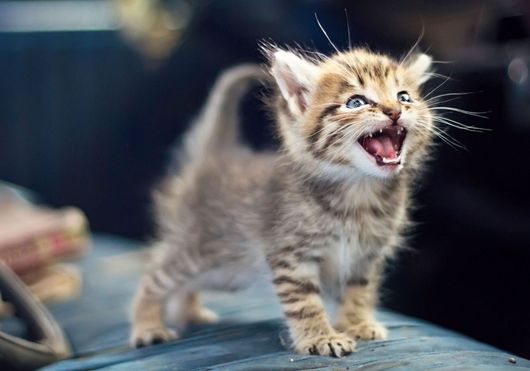In the wild, animals need to reproduce sounds to communicate with their relatives, find a partner, call their young, and scare away enemies.
Pets use their voice to communicate with their owners and to express their emotions, needs, and health.
The range of sounds that cats make is very diverse, from low purring and meowing to high-pitched screams and hissing.
A cat’s “talkativeness” depends on its lifestyle, emotionality, and how much the owner encourages the cat to reproduce sounds during communication. As a result, a stable reaction is formed, which is a reflex and is expressed by a certain behavior of the cat, including the use of voice, when exposed to various stimuli. The cat often meows loudly while running to the bowl and licking it, believing that this vocal behavior will speed up the feeding process.

The voice is an additional tool for a pet to attract the owner’s attention to satisfy its needs or to express its attitude to an event (feeding, affection, communication, fear when visiting a veterinarian, etc.). At the same time, over time, a domestic cat, to get what it wants, for example, food, begins to intensively use sound signals (vocalization), which can cause concern to owners. But the more you address the cat talk to it, the more often it will “answer” you.
Vocalization in animals can be physiological (natural) and pathological, in the case of any problems with behavior or health.
Domestic cats naturally vocalize in the form of loud and inviting meowing when they want to eat, ask for the door to be opened, call kittens, or greet their owner.
When a cat purrs and “chatters”, it means that it is calm and content, well-fed, and warm and its owner is nearby.
A cat meows anxiously and often when stressed when it feels insecure or afraid. In a carrier during transportation, a domestic cat, so taciturn at home, begins to make various sounds and surprise its owners. Often, cats start to meow more often when moving to a new place, in a car, in a queue to see a veterinarian, when meeting other animals, or when parting with relatives if there are repairs at home or strangers. When the impact of stress disappears, or the cat gets used (its nervous system adapts) to new conditions, the animal, as a rule, calms down.
In uncastrated cats, the reproductive instinct forces the animal to look for a partner to continue the family line. Unfulfilled sexual function and the peculiarities of the cats’ physiology force the pet to walk around the apartment and meow loudly for days and weeks.

Meowing can also be an alarming symptom
Severe behavioral disturbances, excessive fearfulness, or aggressiveness are accompanied by increased vocalization in the cat, hissing, and low growling. In this way, the animal warns of an impending attack, becomes dangerous to others, and can cause injuries.
Some diseases in cats cause frequent meowing. For example, vocalization in a cat after using the toilet may indicate problems with the urinary system. But it is also possible that a clean cat is asking to clean up the litter box.
Severe pain, such as that caused by injuries in domestic cats, is often accompanied by increased meowing and anxiety in the animal. In older cats, decreased vision and hearing lead to vocalization, making it difficult for the animal to navigate the room. Other diseases in the animal may also be accompanied by increased vocalization of varying degrees.
The main task of the owner is to know the pet’s habits and constantly monitor them. Domestic animals talk to us with their body language and voice, communicating their needs, fears, or illnesses. An attentive attitude to a domestic cat and understanding the motives of behavior will improve the quality of its life, reduce stress in the animal, and promptly contact a veterinarian in case of illness.
